Last week Artful Kitchens hit the road again for a mini-trip to my hometown, Miami. I was excited to re-connect with some of the great people I met earlier this year on my visit to the Cevisama tradeshow (if you missed that, you can read about it here) with Tile of Spain. I was not disappointed!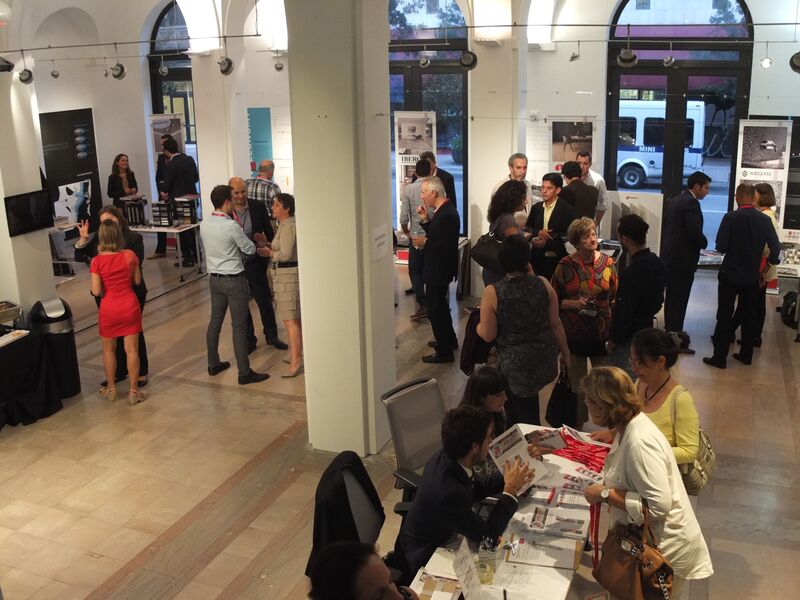 Ceramic Solutions-Innovations Pushing Boundaries of Design was held at the Miami Center for Architecture & Design, presented by Tile of Spain. Several of the big Spanish tile companies were also on hand showing their wares and I'm happy to report that their innovative products are readily available to us here in South Florida and other parts of the US.
Ceramic Solutions-Innovations Pushing Boundaries of Design was held at the Miami Center for Architecture & Design, presented by Tile of Spain. Several of the big Spanish tile companies were also on hand showing their wares and I'm happy to report that their innovative products are readily available to us here in South Florida and other parts of the US.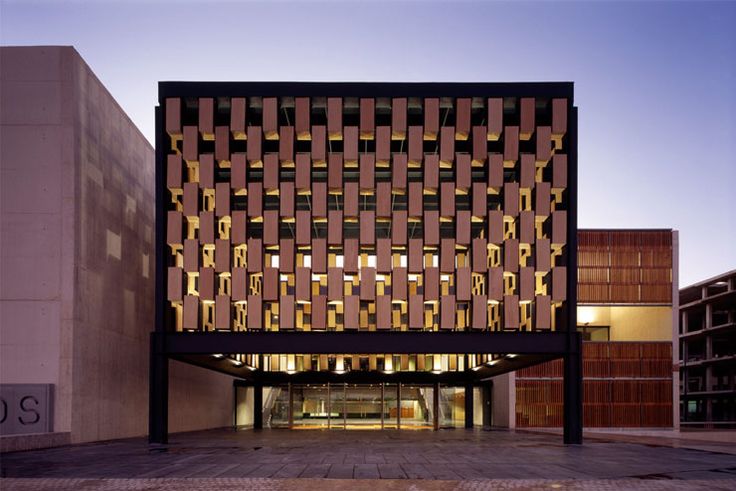 The big "takeaway" of the evening, besides seeing my peeps, was hearing Dr. Martin Bechthold, Professor, Harvard GSD, talk tile from a historical and architectural point of view. Clay has been used in the arts since ancient times and ceramic tile has a long history as a covering, or finish material. Now new technologies are utilizing ceramic tile architecturally and structurally!
The big "takeaway" of the evening, besides seeing my peeps, was hearing Dr. Martin Bechthold, Professor, Harvard GSD, talk tile from a historical and architectural point of view. Clay has been used in the arts since ancient times and ceramic tile has a long history as a covering, or finish material. Now new technologies are utilizing ceramic tile architecturally and structurally!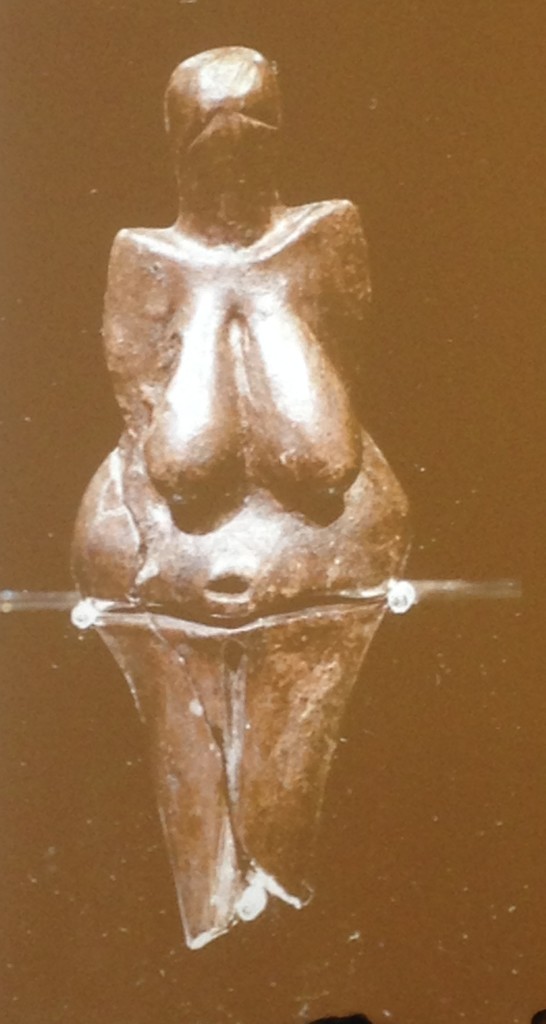 Next up was Tile of Spain Consultant Ryan Fasan who gave us an overview of the latest tile trends along with solid knowledge that is so useful in helping me to educate clients on the best products.
Next up was Tile of Spain Consultant Ryan Fasan who gave us an overview of the latest tile trends along with solid knowledge that is so useful in helping me to educate clients on the best products. 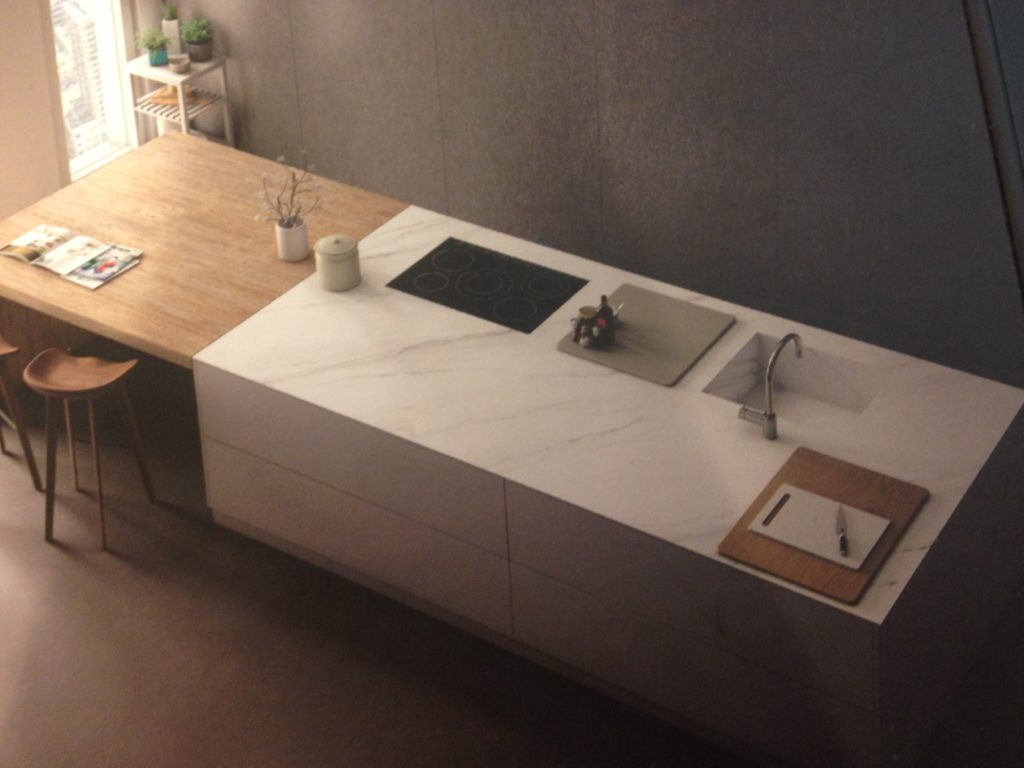 The sleek thin look of large format porcelain for counter tops is a current favorite of mine. Can you blame me? Consider it as an option if you're looking for a contemporary Euro vibe in your kitchen.
The sleek thin look of large format porcelain for counter tops is a current favorite of mine. Can you blame me? Consider it as an option if you're looking for a contemporary Euro vibe in your kitchen.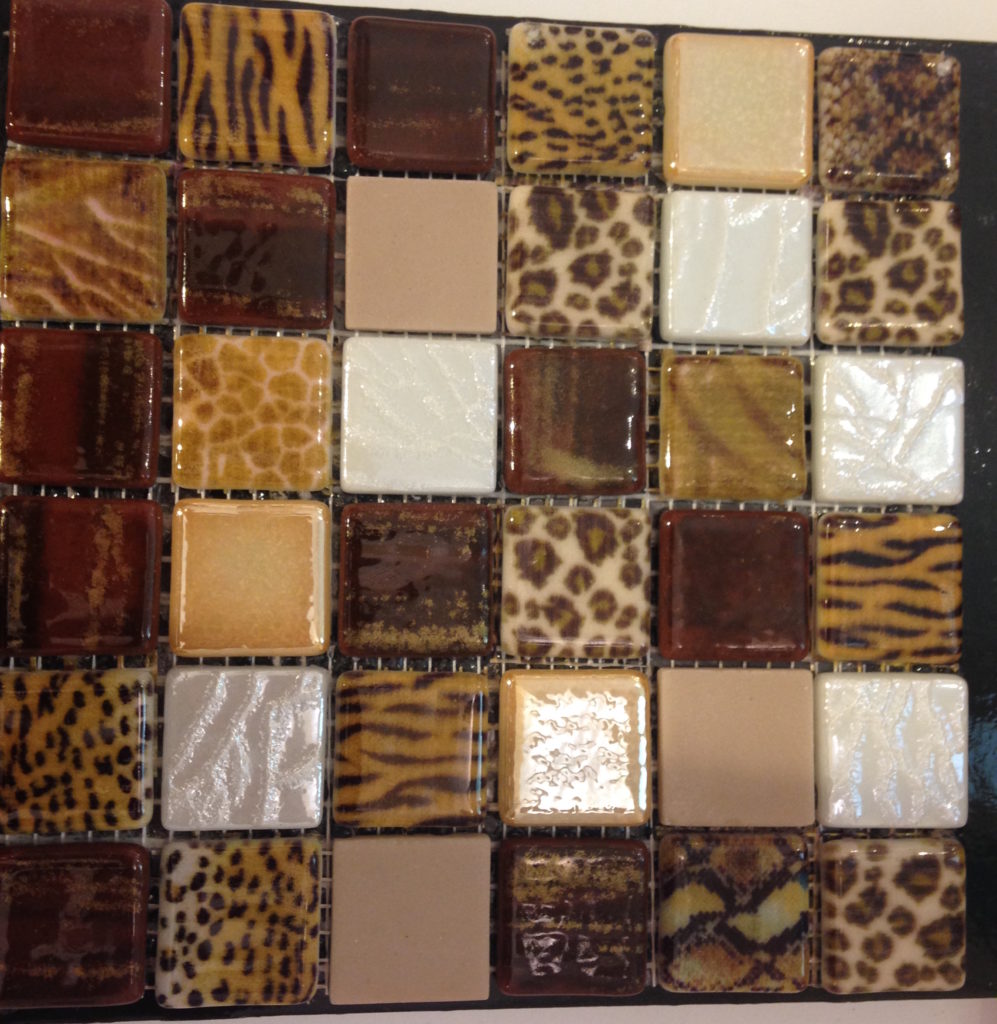 Breakthroughs in digital ink jet printing on tile allow for infinite possibilities. Tile can also be used to cool or heat your home due to their thermo dynamic properties.
Breakthroughs in digital ink jet printing on tile allow for infinite possibilities. Tile can also be used to cool or heat your home due to their thermo dynamic properties.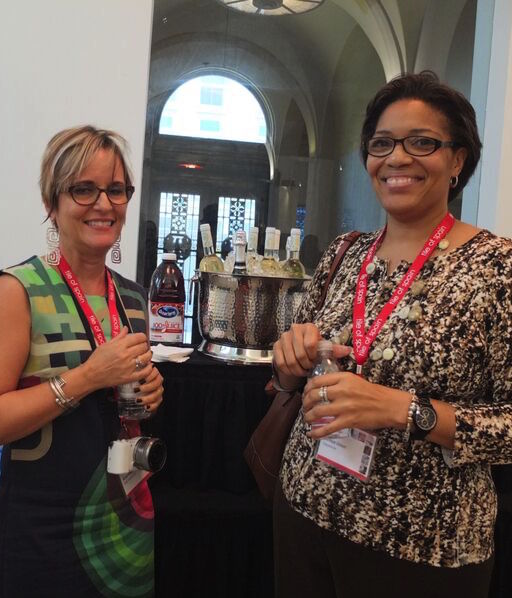 It's just like Tile of Spain to round out the experience with a literal taste of Spain! We enjoyed tapas, a traditional paella and Spanish wine.
It's just like Tile of Spain to round out the experience with a literal taste of Spain! We enjoyed tapas, a traditional paella and Spanish wine.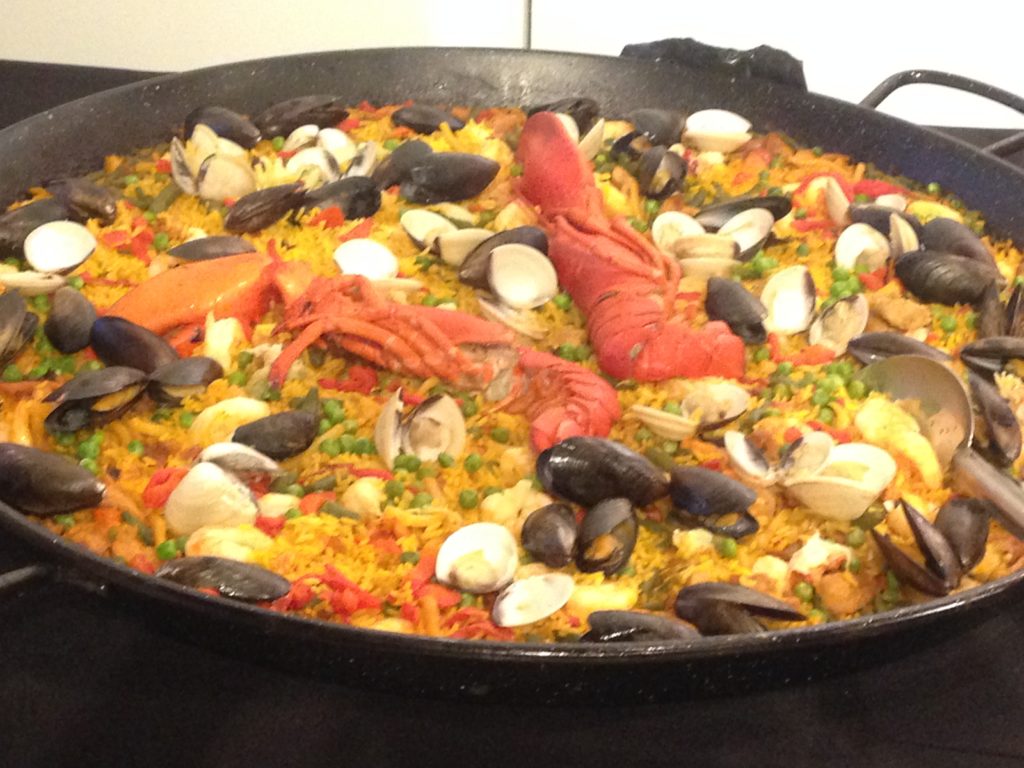 Tile of Spain is the international brand representing 125 ceramic tile manufacturers belonging to the Spanish Ceramic Tile Manufacturer's Association (ASCER).
Tile of Spain is the international brand representing 125 ceramic tile manufacturers belonging to the Spanish Ceramic Tile Manufacturer's Association (ASCER).
Tile Tuesday: The Many Meanings of "Encaustic"
What is encaustic painting?As an artist, I love the sensuousness of working in the encaustic medium which I discovered in 2008. Encaustic painting involves beeswax, resin and pigments in varying combinations. They are mixed together and applied to a panel in layers which are fused with a torch or heat gun. This is where the name comes from. The Greek work “encaustikos” means to heat or burn.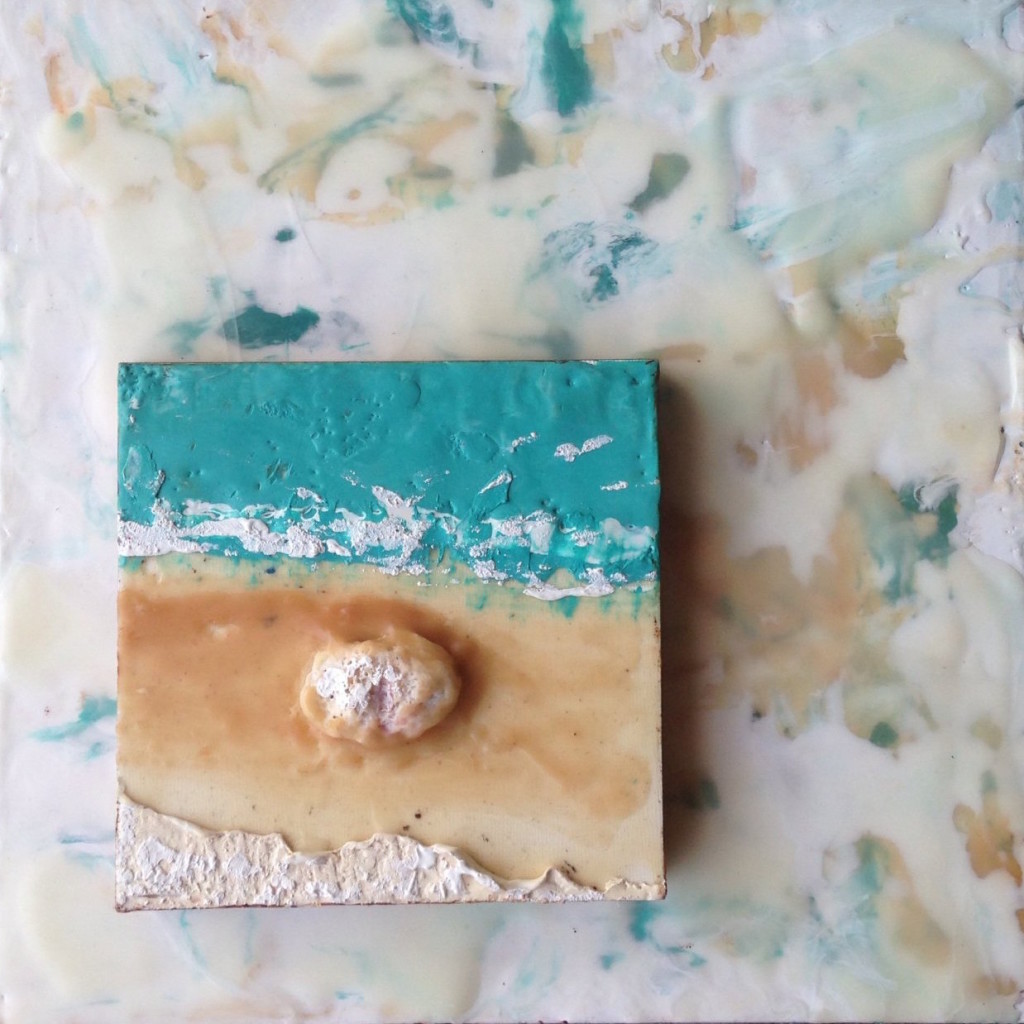 Encaustic painting predates oil painting and was used to create portraits on mummy casings dating back to 100BC in Egypt. These paintings are known as the "Fayum" portraits. Many have survived because beeswax is extremely stable so the pigments do not fade over time.
Encaustic painting predates oil painting and was used to create portraits on mummy casings dating back to 100BC in Egypt. These paintings are known as the "Fayum" portraits. Many have survived because beeswax is extremely stable so the pigments do not fade over time.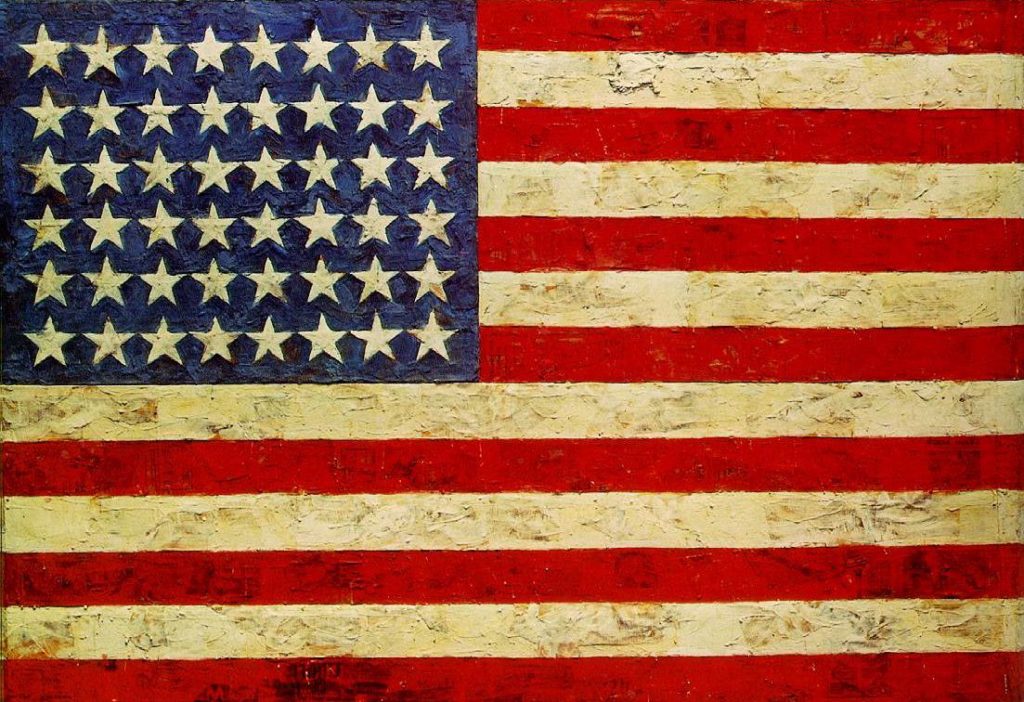 The technique fell into obscurity but was resurrected in the 1950s by artist Jasper Johns. You remember this painting, no? It’s an encaustic painting! Fast forward to the twenty first century and you will find more and more artists working with wax and incorporating it into their repetoire.
The technique fell into obscurity but was resurrected in the 1950s by artist Jasper Johns. You remember this painting, no? It’s an encaustic painting! Fast forward to the twenty first century and you will find more and more artists working with wax and incorporating it into their repetoire. 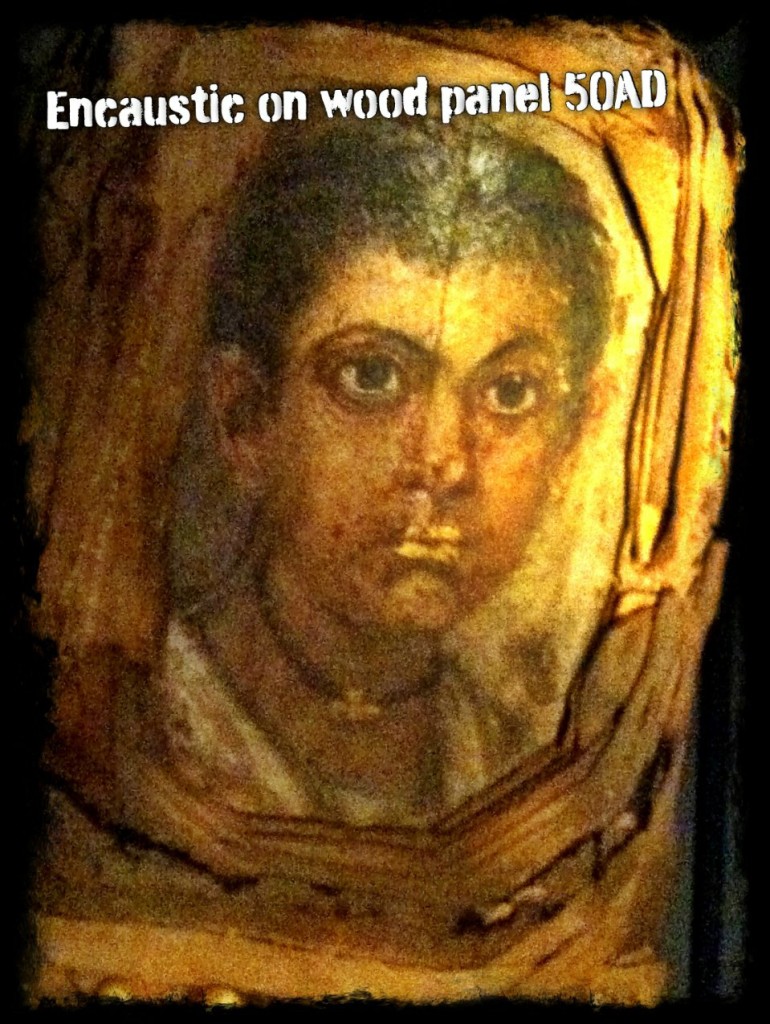 The Name GameIn the pursuit of all things tile, while on my trip to the Cevisama tile trade show with Tile Of Spain, I discovered something called “encaustic tile”. No one could actually tell me how it was connected to what I knew to be encaustic art so I decided to find out.
The Name GameIn the pursuit of all things tile, while on my trip to the Cevisama tile trade show with Tile Of Spain, I discovered something called “encaustic tile”. No one could actually tell me how it was connected to what I knew to be encaustic art so I decided to find out. 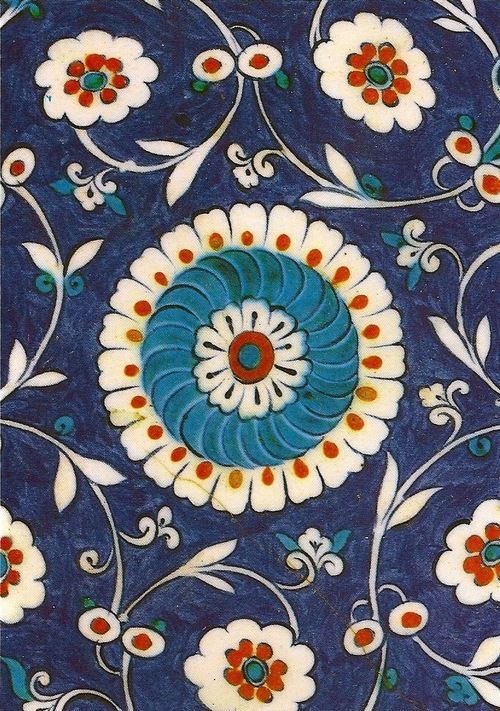 Guess what? There is no connection. Here’s what I discovered:Encaustic tile is also referred to as cement tile, inlaid tile and hydraulic tile. The name“encaustic” with reference to tile, comes from the nineteenth century. Turns out there is a third type of encaustic! It is also the name of a process of medieval enameling involving wax. Victorians thought that inlaid tile resembled this enamel work and began to refer to it as encaustic. The intricate patterns and designs of encaustic tile mimic the encaustic enameling process. It is a total misnomer but the name “Encaustic tile” stuck.
Guess what? There is no connection. Here’s what I discovered:Encaustic tile is also referred to as cement tile, inlaid tile and hydraulic tile. The name“encaustic” with reference to tile, comes from the nineteenth century. Turns out there is a third type of encaustic! It is also the name of a process of medieval enameling involving wax. Victorians thought that inlaid tile resembled this enamel work and began to refer to it as encaustic. The intricate patterns and designs of encaustic tile mimic the encaustic enameling process. It is a total misnomer but the name “Encaustic tile” stuck. 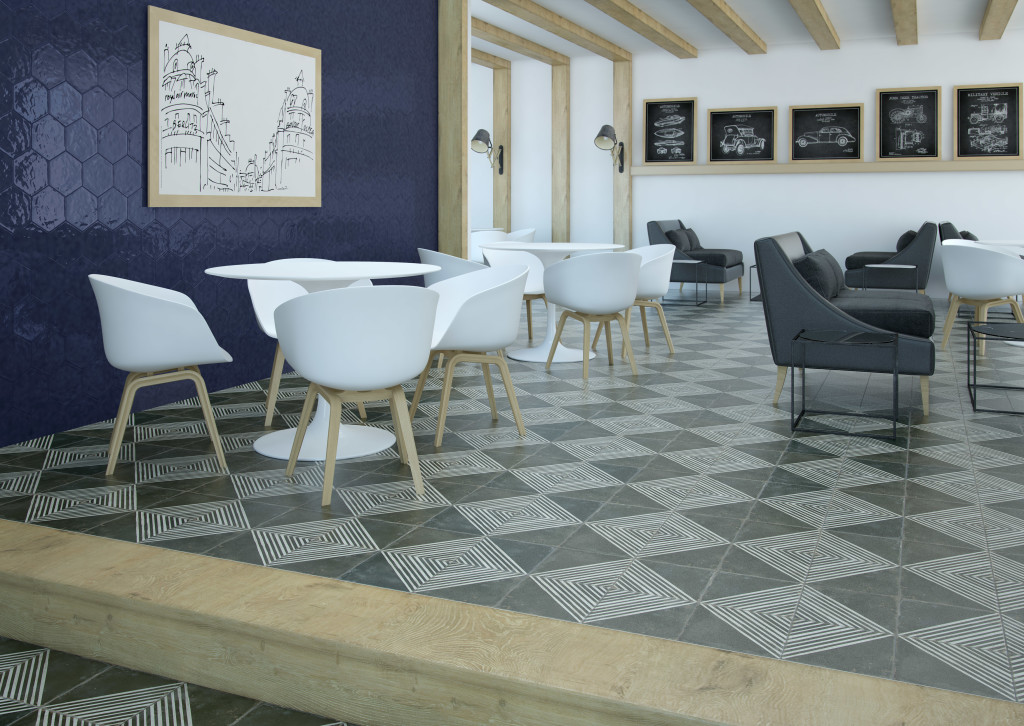 So what is encaustic tile?Cement tiles are not fired; there is no glaze layer on the surface of the tile. They derive their durability from the combination of finely dehydrated ground Portland cement layer and a more coarse layer of sand and cement. The pigment layer is hydraulically pressed into the surface and becomes a part of the tile. This merging of two layers creates the typically crisp clean patterns.
So what is encaustic tile?Cement tiles are not fired; there is no glaze layer on the surface of the tile. They derive their durability from the combination of finely dehydrated ground Portland cement layer and a more coarse layer of sand and cement. The pigment layer is hydraulically pressed into the surface and becomes a part of the tile. This merging of two layers creates the typically crisp clean patterns.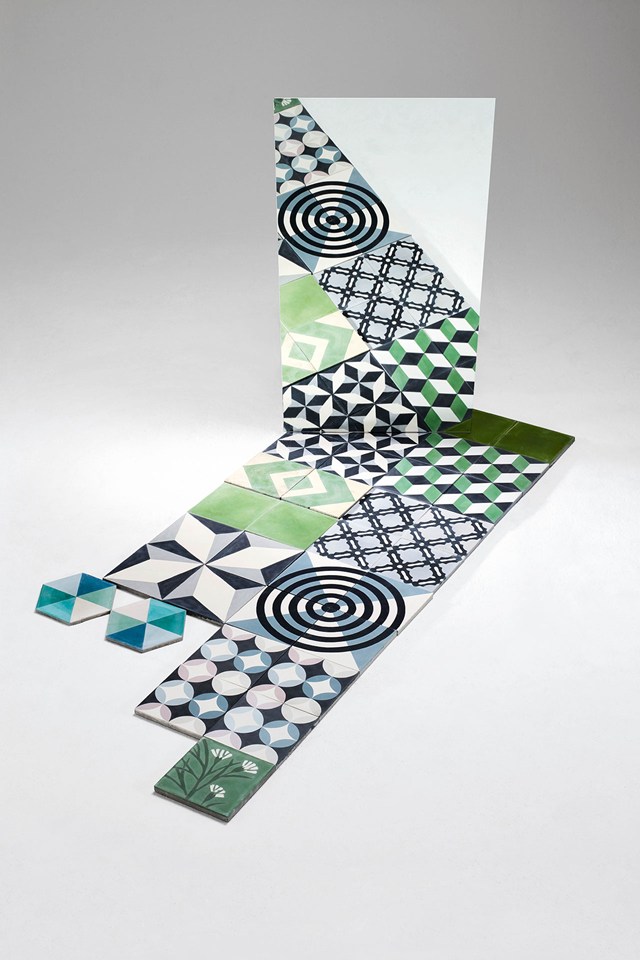 Originally these tiles were handmade but naturally today they are mass produced as described above. Encaustic, or cement tiles are known for their durability as floor tile and have lasted centuries. This explanation only scratches the surface as each country town and village in Italy, Spain, Mexico, Turkey etc. has its own history with the technique.
Originally these tiles were handmade but naturally today they are mass produced as described above. Encaustic, or cement tiles are known for their durability as floor tile and have lasted centuries. This explanation only scratches the surface as each country town and village in Italy, Spain, Mexico, Turkey etc. has its own history with the technique.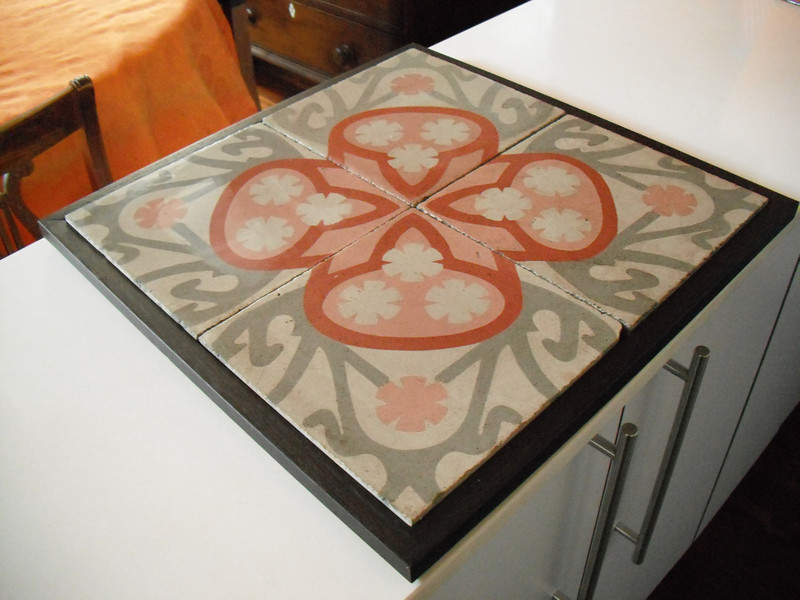 In my research I also came across the work of Benedicte Bodard. She lives in Barcelona where she salvages cement tile from dumpsters. With a little TLC ,she recreates them into furniture, wall hangings and more.So there you have it. If you have more info or would like to continue the conversation, email me or come by and visit on FaceBook.-------------------------------------------------------------------------------------------------------Update: Since posting this on Tuesday I have heard from designer Lundy Wilder of Villa Lagoon Tile. Not only is she an expert on cement tile, she even has a blog devoted to it! Here's what she had to add to the conversation: "Today's cement tiles are indeed still hand made all over the world. Ours are made in the Caribbean, Morocco, Vietnam, and Mexico. We have been to the factories (workshops is more fitting word) and know the owners well, all our cement tiles are made by hand.
In my research I also came across the work of Benedicte Bodard. She lives in Barcelona where she salvages cement tile from dumpsters. With a little TLC ,she recreates them into furniture, wall hangings and more.So there you have it. If you have more info or would like to continue the conversation, email me or come by and visit on FaceBook.-------------------------------------------------------------------------------------------------------Update: Since posting this on Tuesday I have heard from designer Lundy Wilder of Villa Lagoon Tile. Not only is she an expert on cement tile, she even has a blog devoted to it! Here's what she had to add to the conversation: "Today's cement tiles are indeed still hand made all over the world. Ours are made in the Caribbean, Morocco, Vietnam, and Mexico. We have been to the factories (workshops is more fitting word) and know the owners well, all our cement tiles are made by hand.
An Artful New Adventure!
Let’s face it, things change. As we navigate those twists and turns of fate we can only hope to move forward, seeing new things with a fresh eye. Like it or not, change is a constant. You can dread it (understandable) or you can choose to embrace it. That said, it has been more than five years since I began my adventure as Kitchens for Living. I believe I have been true to my promise to share the latest design trends and product info for the heart of your home. We have frequently ventured out of the kitchen and even around the globe! I am so grateful for all the wonderful and talented kindred souls I have met along the way, fellow bloggers, designers and great organizations such as Modenus, Blanco, Brizo, Tile of Spain and many more. This blog has afforded me the opportunity to travel and bear witness to marvelous destinations and inspiring trade shows. Before this starts sounding too sad, let me tell you I have never felt so excited about the future and eager to explore new opportunities.
I believe I have been true to my promise to share the latest design trends and product info for the heart of your home. We have frequently ventured out of the kitchen and even around the globe! I am so grateful for all the wonderful and talented kindred souls I have met along the way, fellow bloggers, designers and great organizations such as Modenus, Blanco, Brizo, Tile of Spain and many more. This blog has afforded me the opportunity to travel and bear witness to marvelous destinations and inspiring trade shows. Before this starts sounding too sad, let me tell you I have never felt so excited about the future and eager to explore new opportunities. 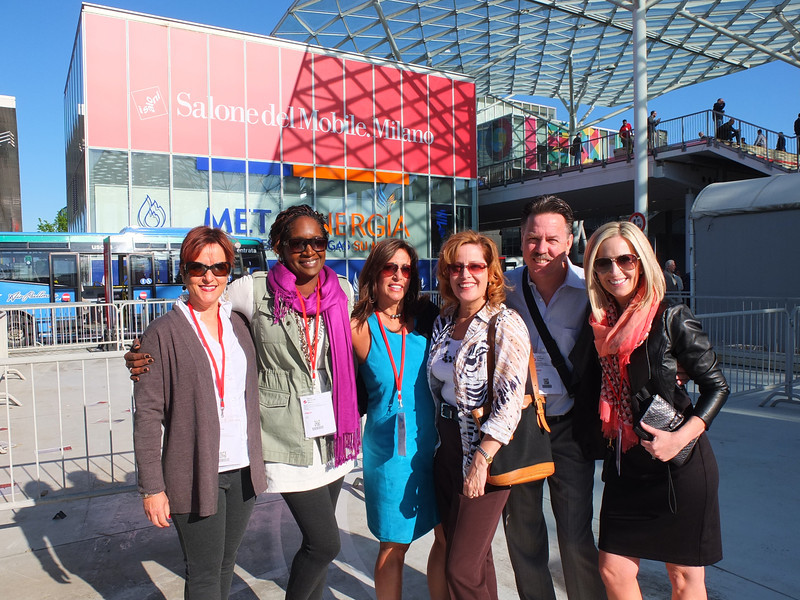 This will be the last post for Kitchens for Living. From now on I will be able to merge two of the things I love, kitchen design and art with my new site, Artful Kitchens. A big THANK YOU to Leslie Carothers of The Kaleidoscope Partnership for her guidance and insight which lead me to discover a new path full of promise and possibilities.
This will be the last post for Kitchens for Living. From now on I will be able to merge two of the things I love, kitchen design and art with my new site, Artful Kitchens. A big THANK YOU to Leslie Carothers of The Kaleidoscope Partnership for her guidance and insight which lead me to discover a new path full of promise and possibilities. 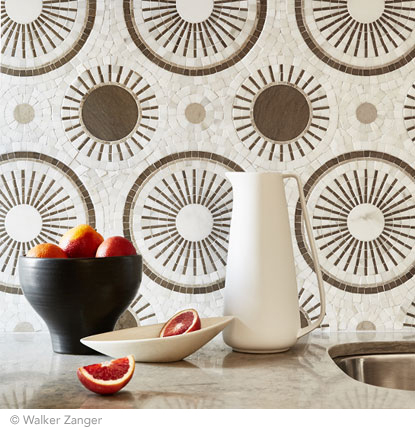 Artful Kitchens will focus on all the ways you can use creativity to personalize your kitchen. Artful spaces reflect who you are and the way you live.
Artful Kitchens will focus on all the ways you can use creativity to personalize your kitchen. Artful spaces reflect who you are and the way you live.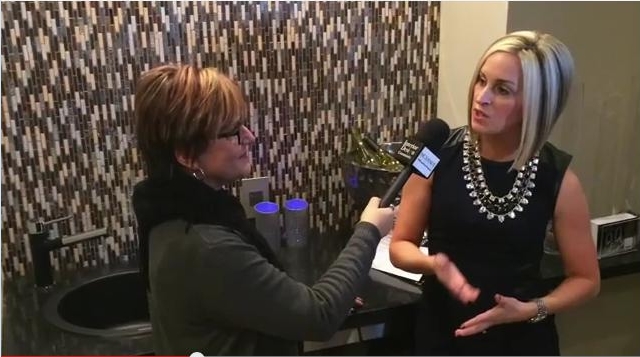 The stunning tile above, by Walker Zanger, was featured at KBIS 2015 which I had the pleasure of attending with The Modenus Blog Tour Vegas.
The stunning tile above, by Walker Zanger, was featured at KBIS 2015 which I had the pleasure of attending with The Modenus Blog Tour Vegas. 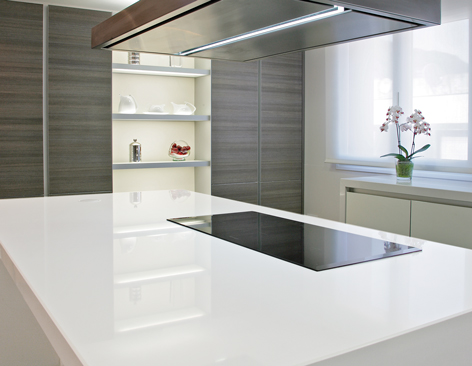 New products like this perfectly white quartz by Wilsonart enhance the kitchen with a feeling of crisp clean freshness!
New products like this perfectly white quartz by Wilsonart enhance the kitchen with a feeling of crisp clean freshness!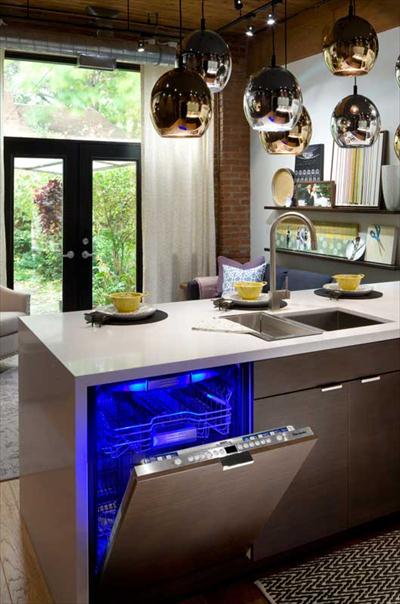 Color is a primary element of the Artful Kitchen. We'll be talking a lot about that in an upcoming interview with Amy Wax of Color 911
Color is a primary element of the Artful Kitchen. We'll be talking a lot about that in an upcoming interview with Amy Wax of Color 911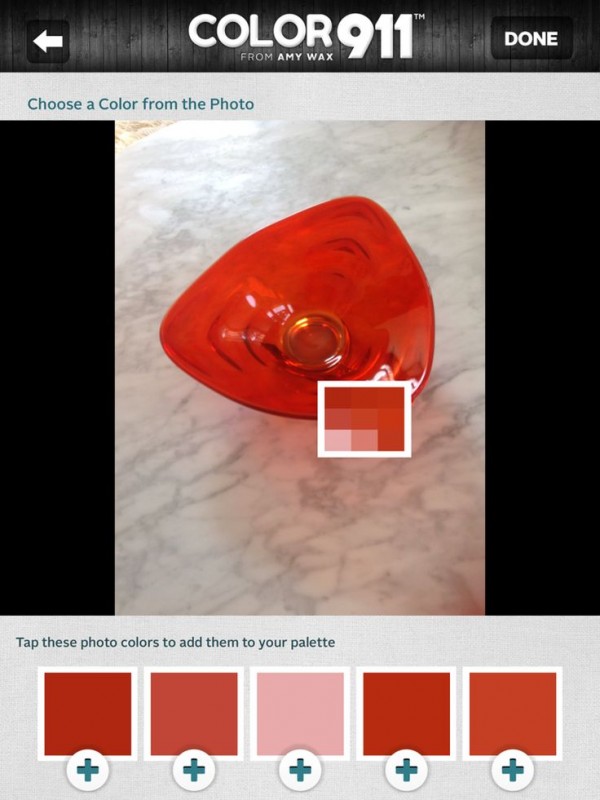 We will continue to incorporate new products and technologies as they emerge and we will explore all the artful ways of creating a kitchen that reflects who you really are. I’m so excited, I hope you’ll join me and spread the word. Last but certainly not least, whether you are a brand or a consumer, I want to collaborate with you!
We will continue to incorporate new products and technologies as they emerge and we will explore all the artful ways of creating a kitchen that reflects who you really are. I’m so excited, I hope you’ll join me and spread the word. Last but certainly not least, whether you are a brand or a consumer, I want to collaborate with you! 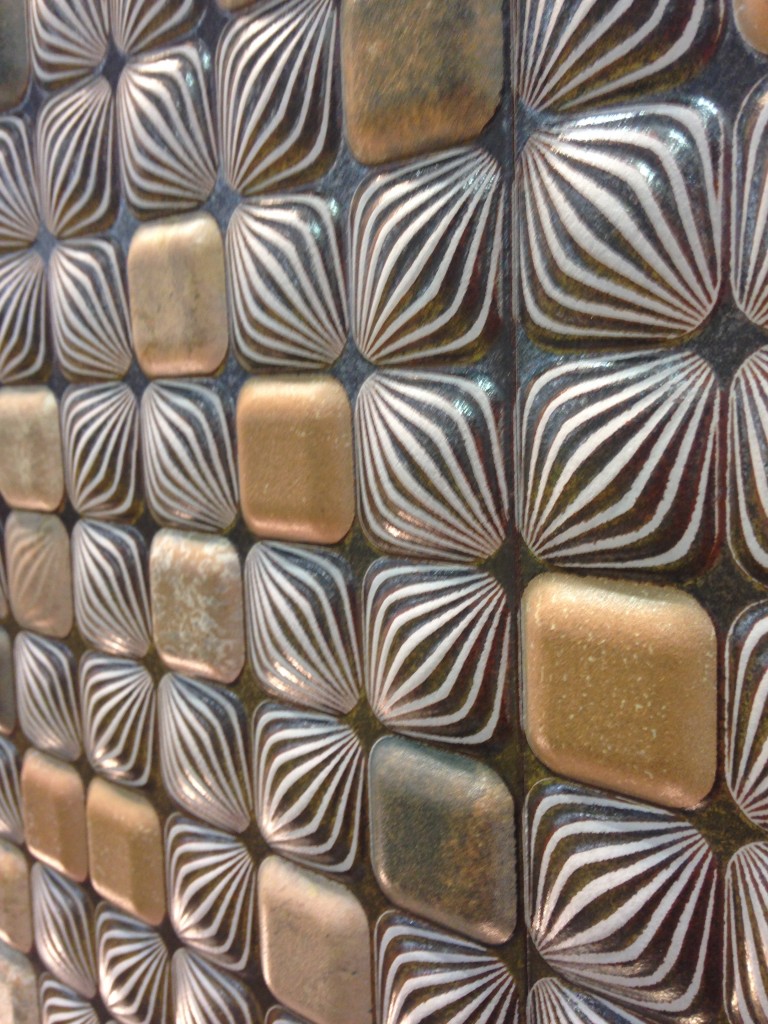 Continue the conversation on Face Book or email me at ArtfulKitchensbyGlo@gmail.com
Continue the conversation on Face Book or email me at ArtfulKitchensbyGlo@gmail.com
Tile Tuesday: Beauty & Knowledge
Welcome the the third installment of Tile Tuesday. If you missed the last two you can catch them here and here.The second half of my adventure with Tile of Spain took us to Valencia, the location of Cevisama, annual trade show held to showcase the latest innovations introduced by the Spanish tile industry.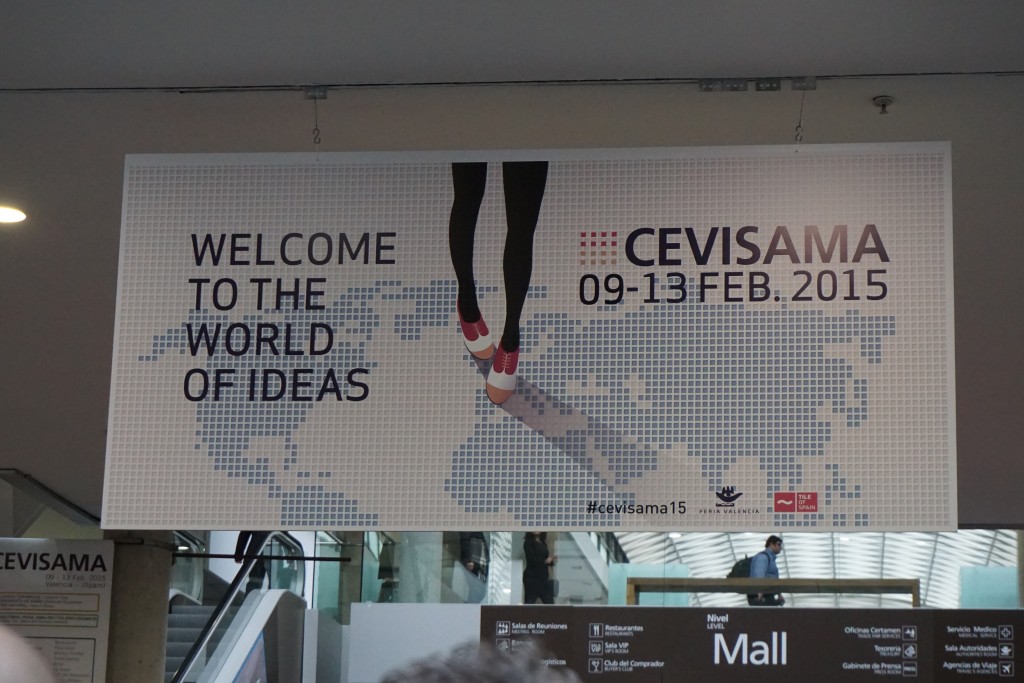 Attending Cevisama was an introduction to a whole world of possibilities! If you’ve been following Tile Tuesday, you already know that ceramic tile is a part of the Spanish culture dating back to Roman and Moorish times. Tile is nothing new but the uses and innovations in the ceramic industry certainly are! In the coming weeks we’ll talk about some of the big trends I saw that you can incorporate into your own kitchen.
Attending Cevisama was an introduction to a whole world of possibilities! If you’ve been following Tile Tuesday, you already know that ceramic tile is a part of the Spanish culture dating back to Roman and Moorish times. Tile is nothing new but the uses and innovations in the ceramic industry certainly are! In the coming weeks we’ll talk about some of the big trends I saw that you can incorporate into your own kitchen.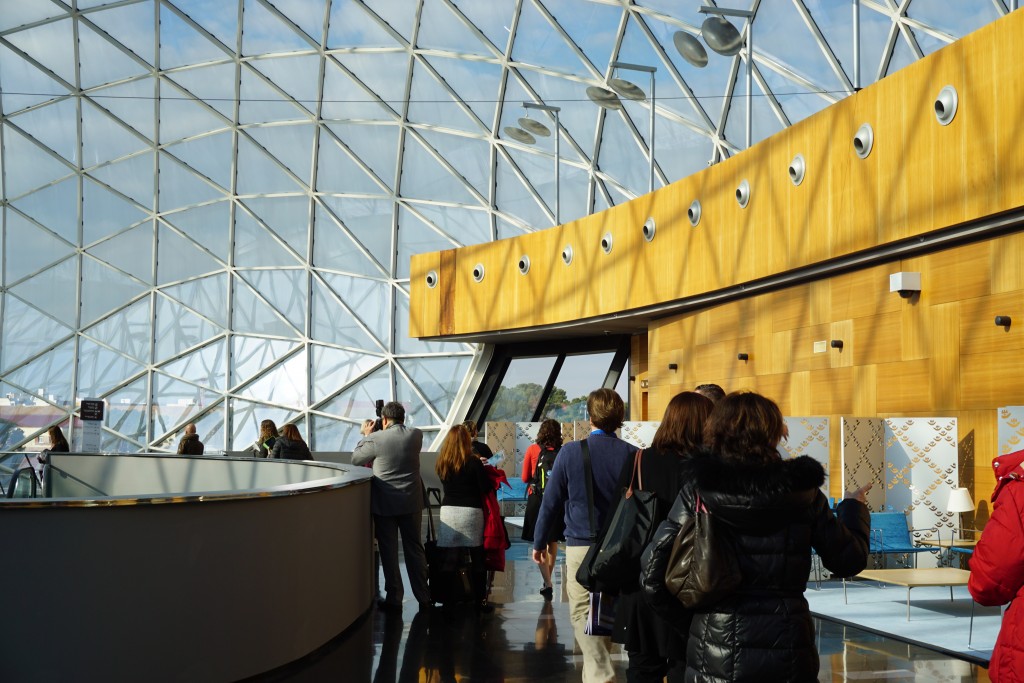 Before we do that let’s cover some good to know, sometimes misunderstood, facts about tile. For your viewing pleasure I have inserted a little eye candy to keep you on your toes!WHAT IS IT?Ceramic tile is a perfect balance of the classical elements of earth (clay), air, water and fire. All are involved in its creation. All tile is made of either red or white clay.
Before we do that let’s cover some good to know, sometimes misunderstood, facts about tile. For your viewing pleasure I have inserted a little eye candy to keep you on your toes!WHAT IS IT?Ceramic tile is a perfect balance of the classical elements of earth (clay), air, water and fire. All are involved in its creation. All tile is made of either red or white clay.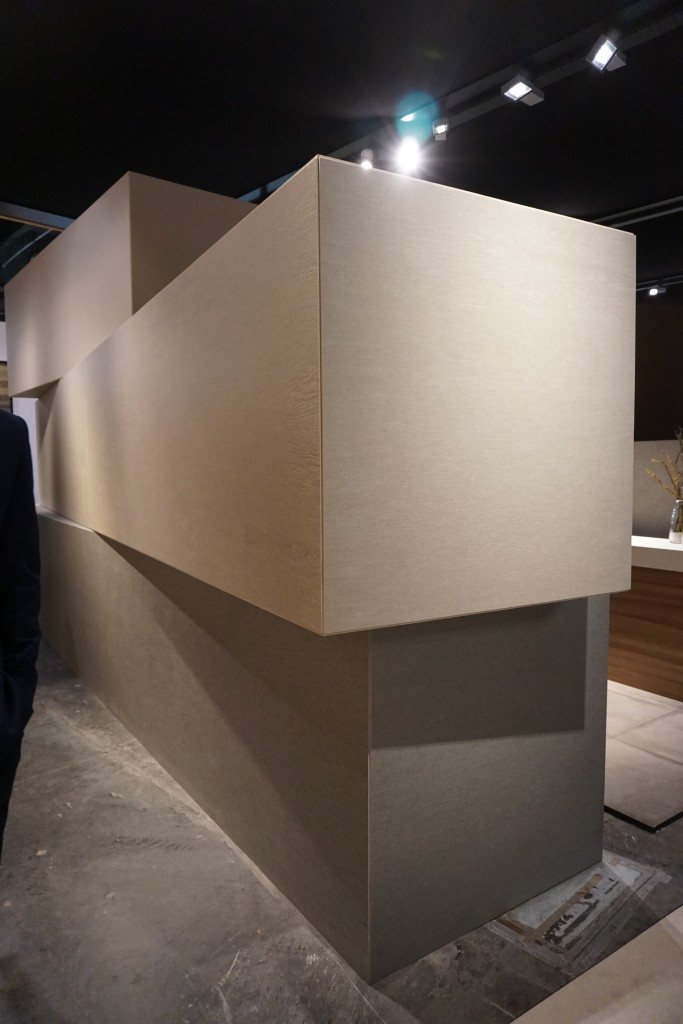 CERAMIC, PORCELAIN OR BOTH?One big question I get regards porcelain vs. ceramic. Guess what? Porcelain tiles ARE ceramic tiles. There is only one technical difference. A tile must have a water absorbtion rate of .05 to be classified as porcelain.
CERAMIC, PORCELAIN OR BOTH?One big question I get regards porcelain vs. ceramic. Guess what? Porcelain tiles ARE ceramic tiles. There is only one technical difference. A tile must have a water absorbtion rate of .05 to be classified as porcelain. 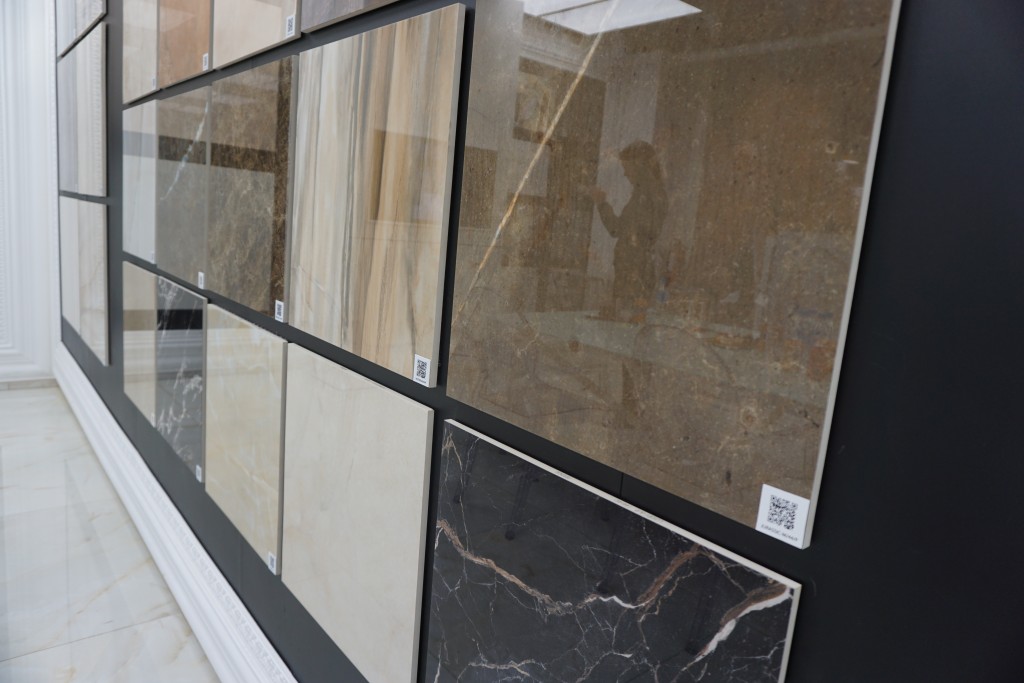 Typically porcelain tiles are denser, less porous and as a result more durable than other ceramics. You can also get them “rectified” which means crisp sharp perfectly squared edges that mean a tight fit with minimal grout lines.IS PORCELAIN THE SAME COLOR ALL THE WAY THROUGH?In the past I believed that a porcelain tile was the same color all the way through so that a small chip would be no big deal but I learned that is not always true. You CAN get something called “through-body porcelain” which means that if the tile is not glazed, the color and texture are consistent all the way through the tile. However porcelain tiles can also have surface glazes and textures that are not “through-body”.
Typically porcelain tiles are denser, less porous and as a result more durable than other ceramics. You can also get them “rectified” which means crisp sharp perfectly squared edges that mean a tight fit with minimal grout lines.IS PORCELAIN THE SAME COLOR ALL THE WAY THROUGH?In the past I believed that a porcelain tile was the same color all the way through so that a small chip would be no big deal but I learned that is not always true. You CAN get something called “through-body porcelain” which means that if the tile is not glazed, the color and texture are consistent all the way through the tile. However porcelain tiles can also have surface glazes and textures that are not “through-body”.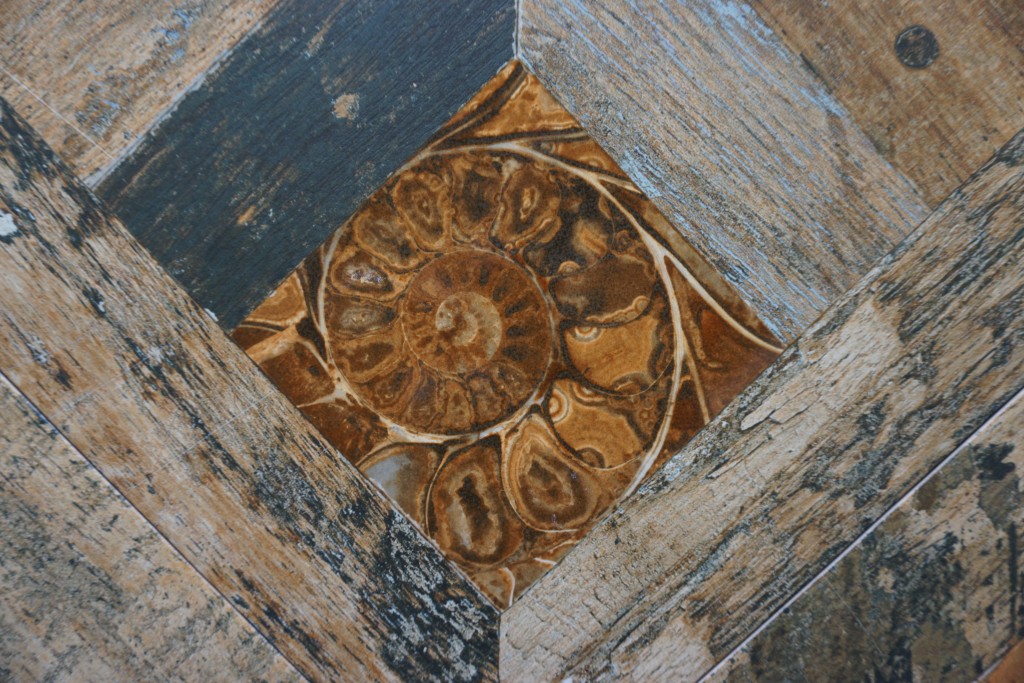 WHERE DOES IT GO?Tiles used for exterior applications are porcelain but not all porcelain tiles are recommended to be used outside. Generally you can put just about any type of tile on the wall but you’re much better off with porcelain on the floor for durability. Remember, although beautiful, glossy finishes are always more slippery than honed, or matte finishes. Got it? Good. Since you made it all the way to the end, I have a special treat for you.
WHERE DOES IT GO?Tiles used for exterior applications are porcelain but not all porcelain tiles are recommended to be used outside. Generally you can put just about any type of tile on the wall but you’re much better off with porcelain on the floor for durability. Remember, although beautiful, glossy finishes are always more slippery than honed, or matte finishes. Got it? Good. Since you made it all the way to the end, I have a special treat for you.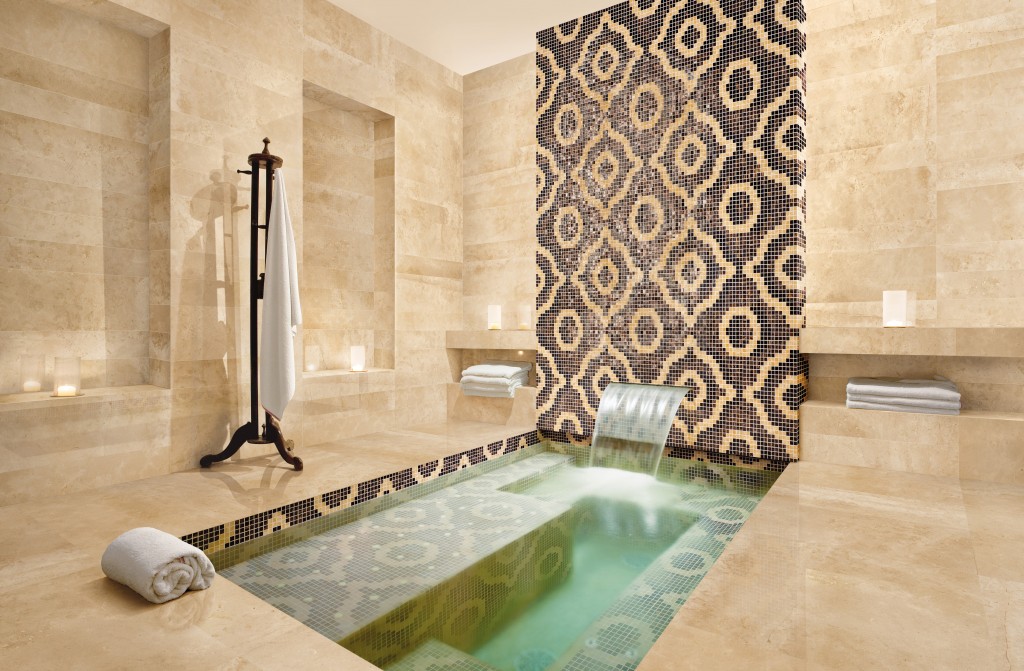 Next Tile Tuesday: Uncovering Valencia with Tile of Spain, perhaps another video slideshow??
Next Tile Tuesday: Uncovering Valencia with Tile of Spain, perhaps another video slideshow??
Tile Tuesday: Parente to Parasol, Old Tradition-New Expression
Welcome to the second installment of the Tile Tuesday series! If you missed part one you can find it right here. If there is one big takeaway from last week's post it is that there are two sides to Sevilla, the constant play between old and new.We were able to really dig in to both aspects on our Tile of Spain tour of Sevilla led by architect Gonzalo Cantos.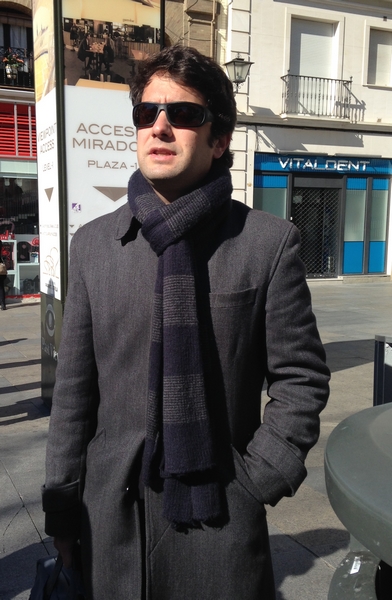 As we explored not only tile but the culture from which it originates, we were constantly presented with old and new, separate but not entirely mutually exclusive. What came before certainly influences the contemporary production.
As we explored not only tile but the culture from which it originates, we were constantly presented with old and new, separate but not entirely mutually exclusive. What came before certainly influences the contemporary production.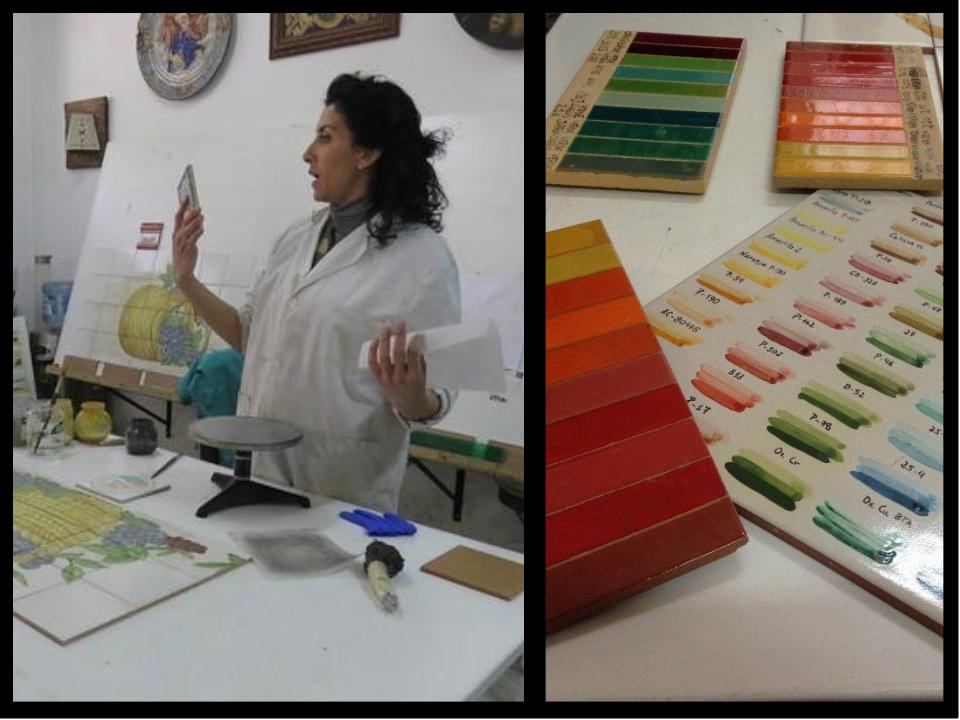 Later in the series we will take a look at modern state-of-the- art tile production in Spain but today I want to introduce you to a true old world style artisan, living and working in Sevilla. Meet Isabel Parente. We visited the studio where she creates her handmade tile and custom glazes. By the way, did you know that most ceramic glazes used today come from Spain?
Later in the series we will take a look at modern state-of-the- art tile production in Spain but today I want to introduce you to a true old world style artisan, living and working in Sevilla. Meet Isabel Parente. We visited the studio where she creates her handmade tile and custom glazes. By the way, did you know that most ceramic glazes used today come from Spain?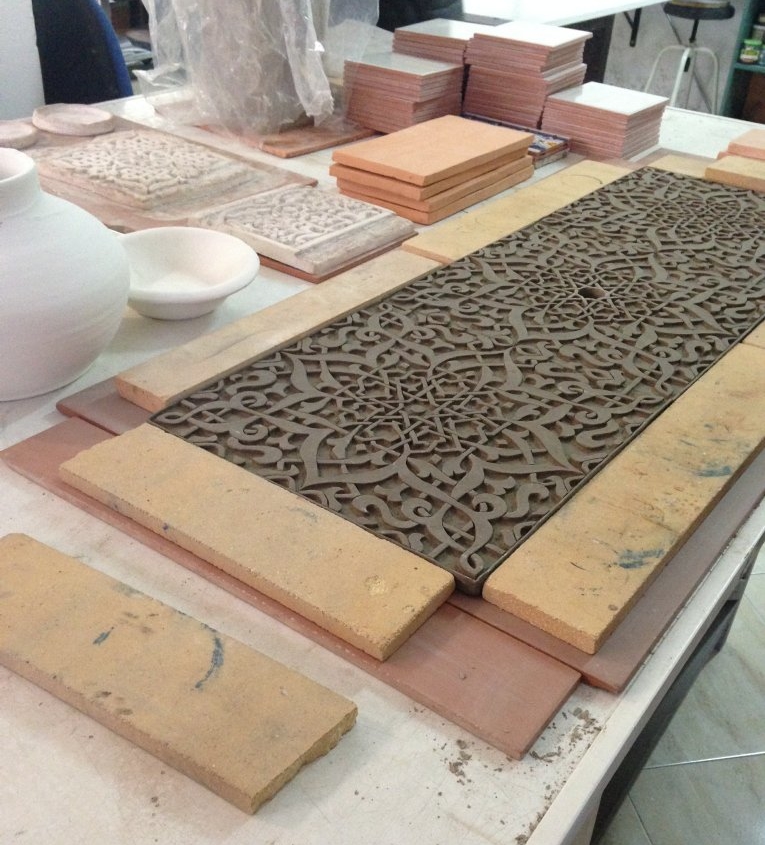 Isabel is mostly self-taught but briefly attended art school in Sevilla, followed by an internship in Perugia, Italy. She demonstrated a few different traditional methods including hand painting. Her practice includes the creation of new commissions as well as restoration.
Isabel is mostly self-taught but briefly attended art school in Sevilla, followed by an internship in Perugia, Italy. She demonstrated a few different traditional methods including hand painting. Her practice includes the creation of new commissions as well as restoration.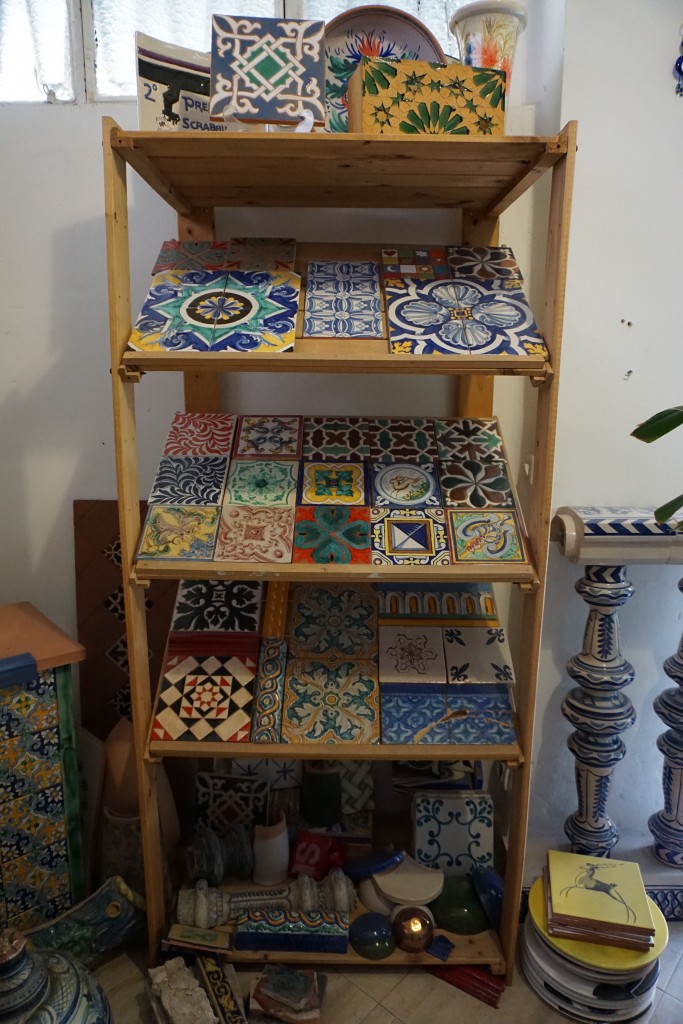 It is interesting to note that with old world techniques (she doesn't even utilize a computer), Isabel is addressing the very current trend towards personalization. You can't get much more custom than what she does!
It is interesting to note that with old world techniques (she doesn't even utilize a computer), Isabel is addressing the very current trend towards personalization. You can't get much more custom than what she does!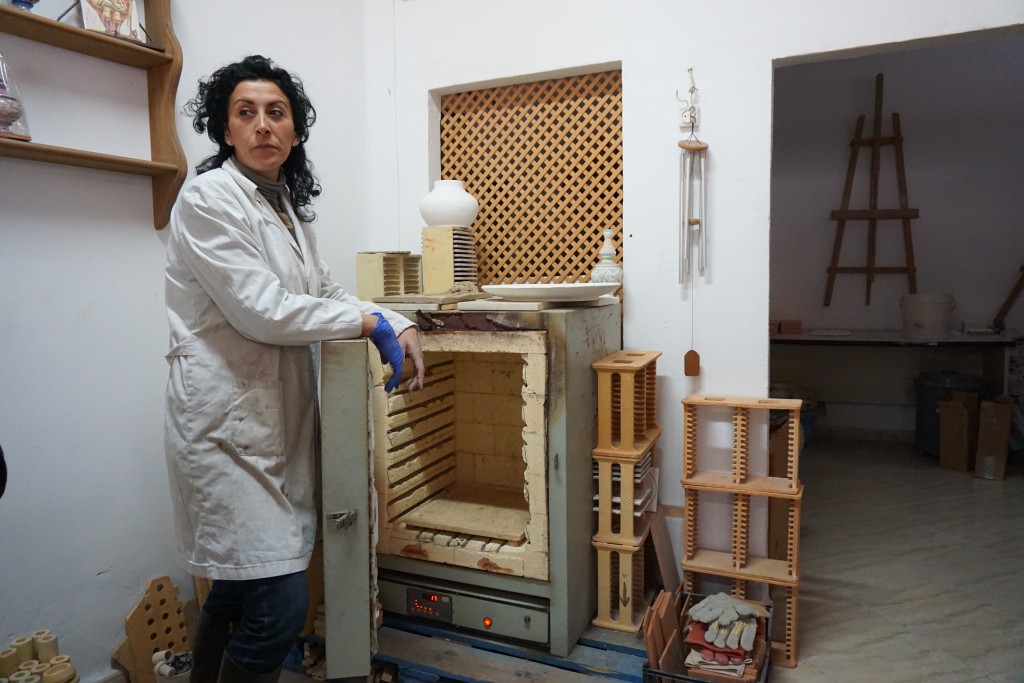 Just about a five minute walk from Isabel's studio you will find Encarnacion Square, the oldest part of Seville and home to one of its most controversial residents, Metropol Parasol. I posted our visit to Parasol in real-time. If you were one of those who wondered exactly what this was, today's your lucky day.
Just about a five minute walk from Isabel's studio you will find Encarnacion Square, the oldest part of Seville and home to one of its most controversial residents, Metropol Parasol. I posted our visit to Parasol in real-time. If you were one of those who wondered exactly what this was, today's your lucky day. 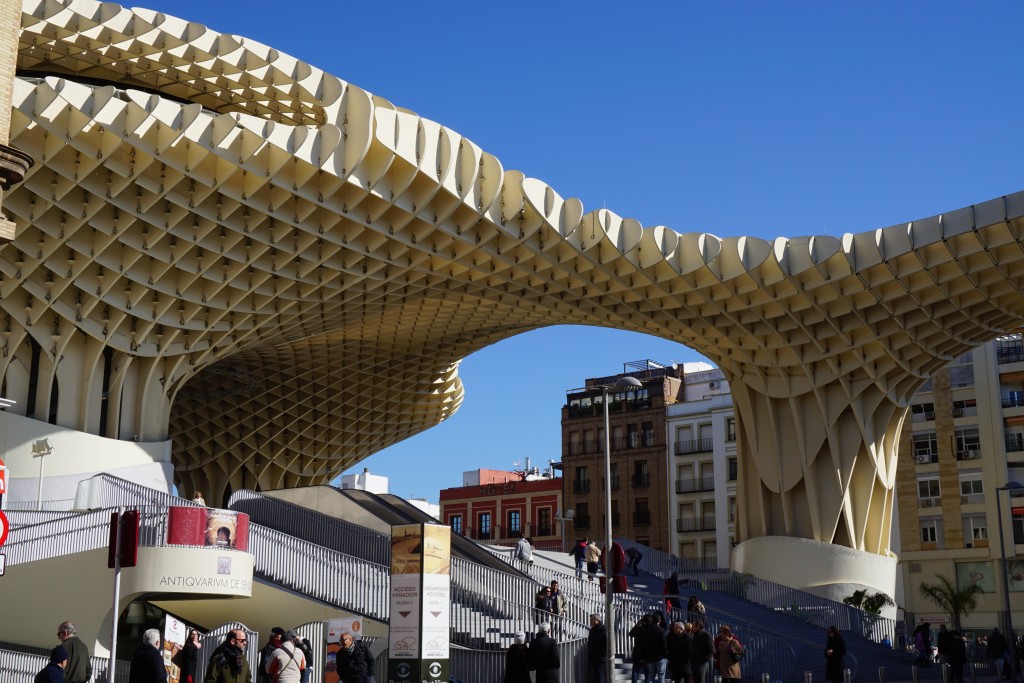 Encarnacion Square was home to a neighborhood market starting in the 19th century up until the 1970s when the area began to languish. Excavation to create a parking lot in the 1990s uncovered ancient Roman ruins below!
Encarnacion Square was home to a neighborhood market starting in the 19th century up until the 1970s when the area began to languish. Excavation to create a parking lot in the 1990s uncovered ancient Roman ruins below! 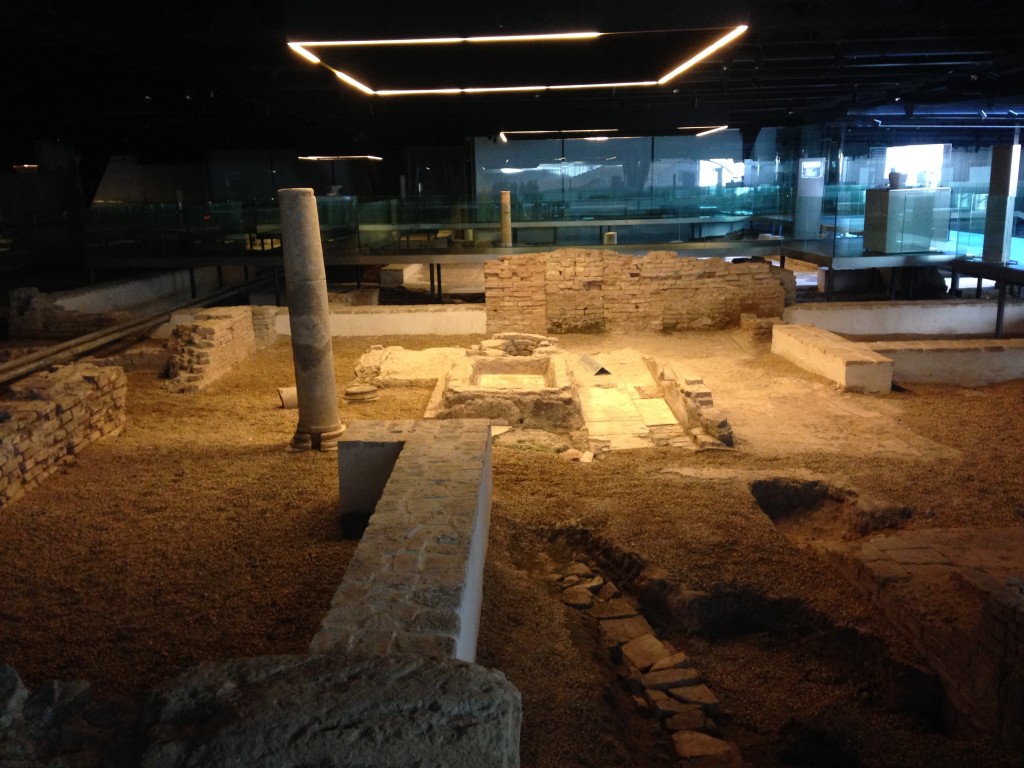 It wasn't until 2004 that the city decided to develop the property. Architect Jurgen Mayer-Hermann was selected and his Metropol Parasol was completed in 2011 at approximately double the 50 million Euro budgeted for the project. Part of the expense was due to technical flaws in his design that had to be overcome. This paired with the fact that its unexpected dramatic presence rubs "traditionalists" the wrong way, is what makes the Parasol a continuing subject of controversy.
It wasn't until 2004 that the city decided to develop the property. Architect Jurgen Mayer-Hermann was selected and his Metropol Parasol was completed in 2011 at approximately double the 50 million Euro budgeted for the project. Part of the expense was due to technical flaws in his design that had to be overcome. This paired with the fact that its unexpected dramatic presence rubs "traditionalists" the wrong way, is what makes the Parasol a continuing subject of controversy. 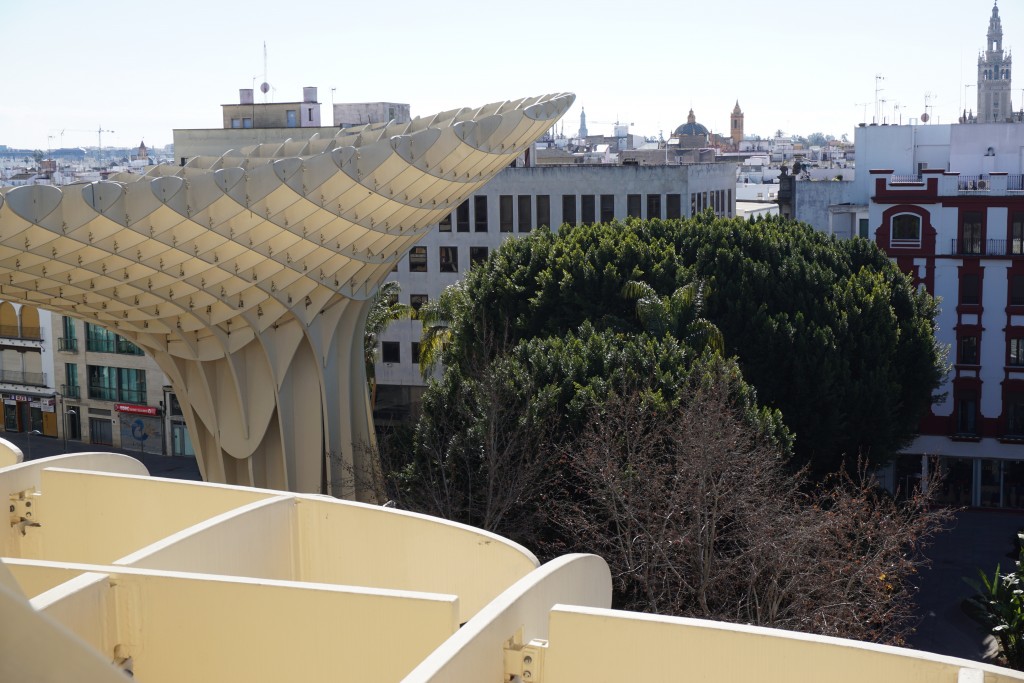 Here's
Here's my another perspective. Mayer-Hermann's inspiration came from the cathedral vaults of nearby Seville cathedral as well as from the large shade producing ficus trees of a neighboring park. In fact shade from the sweltering summer sun was one of his major objectives. In this way it does reference its location quite well. The project is an excellent example of the modern Spanish architecture of undulating curves and waves. Sevillanos refer to it as "Las Setas"(The Mushrooms). Giant "waffles" are made of birch hardwood with a polyurethane finish. 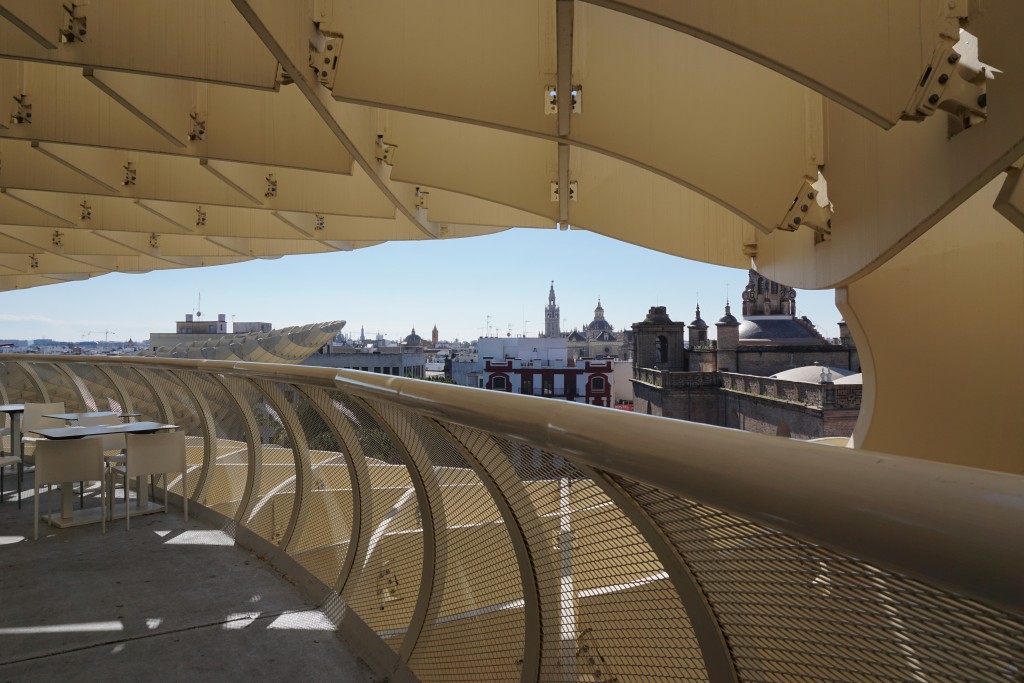 The excavation and restoration of the ruins below continue. On level zero you will find an Antiquarium where you can walk among old Roman buildings. The Parasol above is wholly supported on 8 points so as not to disturb the ruins below. On level one there is, once again, a market. The upper levels house restaurants and a meandering walkway offering various views of the city below.I will say that because of the design of the structure, I felt safely embraced on these walkways, sort of nice if you have a fear of heights!
The excavation and restoration of the ruins below continue. On level zero you will find an Antiquarium where you can walk among old Roman buildings. The Parasol above is wholly supported on 8 points so as not to disturb the ruins below. On level one there is, once again, a market. The upper levels house restaurants and a meandering walkway offering various views of the city below.I will say that because of the design of the structure, I felt safely embraced on these walkways, sort of nice if you have a fear of heights!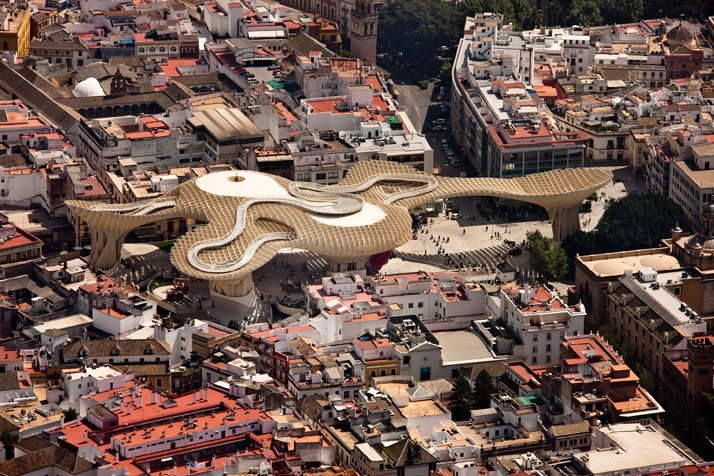 So what's your take? Ugly intrusion or a dramatic blending of old and new concepts exemplifying the new Spanish architecture?Before we leave Seville I want to share my pics with you. In addition to what I have written about here, and in part one, photos include: Plaza de España, Alfonso XIII Hotel, Royal Alcazar of Seville and Seville Cathedral. Now go grab some sangria, kick back and enjoy the sights.Next Tile Tuesday: On to Valencia and what I learned about tile and trends I saw at Cevisama 2015
So what's your take? Ugly intrusion or a dramatic blending of old and new concepts exemplifying the new Spanish architecture?Before we leave Seville I want to share my pics with you. In addition to what I have written about here, and in part one, photos include: Plaza de España, Alfonso XIII Hotel, Royal Alcazar of Seville and Seville Cathedral. Now go grab some sangria, kick back and enjoy the sights.Next Tile Tuesday: On to Valencia and what I learned about tile and trends I saw at Cevisama 2015
Tile Tuesday: The Inspiration of Antiquity
Welcome Tile Tuesday! This is the first installment of a series inspired by my discoveries exploring Seville and Valencia, Spain with Tile of Spain. Not only did we attend Cevisama, the renowned trade fair showcasing the best of the Spanish tile industry, we also explored two cities, their history, culture and architecture with two very passionate local architects. Along the way I learned a lot about ceramic tile in general and that was one of my goals for this trip. Each Tuesday I will be sharing something interesting about tile and the cities we visited. Ceramic tile is the product of the culture in which it is made. Whether you’re talking 1300s or today, tile really is an artefact of the time in which it was produced.
Along the way I learned a lot about ceramic tile in general and that was one of my goals for this trip. Each Tuesday I will be sharing something interesting about tile and the cities we visited. Ceramic tile is the product of the culture in which it is made. Whether you’re talking 1300s or today, tile really is an artefact of the time in which it was produced.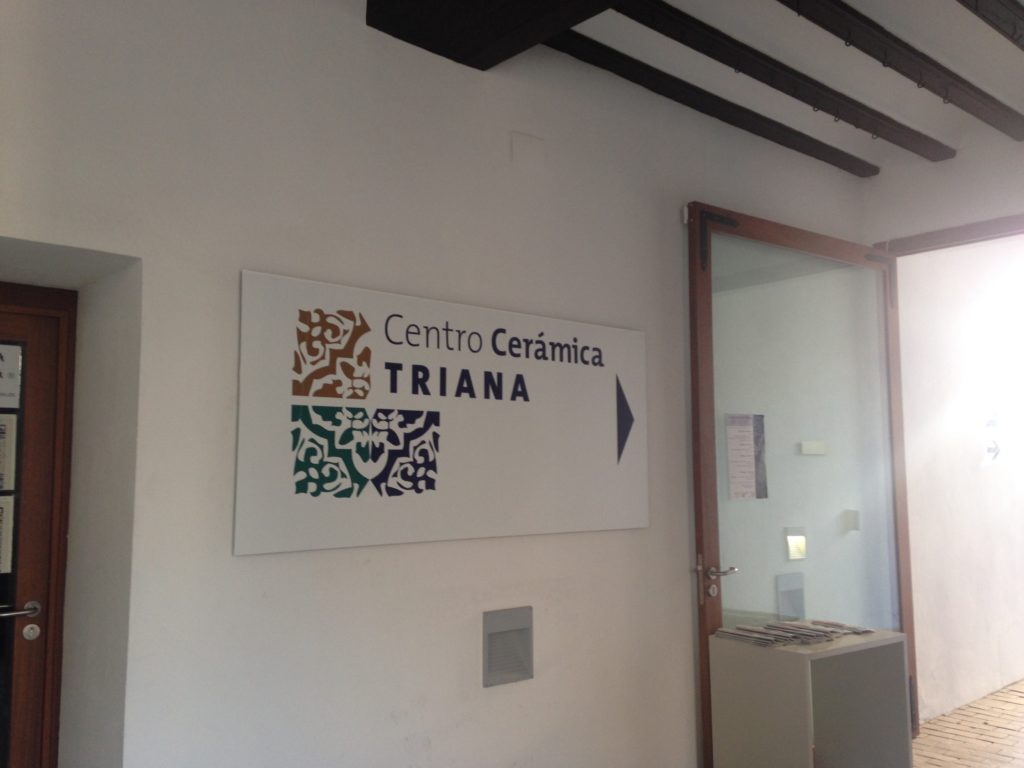 Even the examples we saw of cutting edge 21st century Spanish tile manufacturers such as Peronda, Inalco, Aparici and more have their roots in a much older tradition. What better place to begin than at the beginning. Our adventure started in Seville with a visit to Centro Ceramica Triana, a ceramic museum which was once a tile factory.
Even the examples we saw of cutting edge 21st century Spanish tile manufacturers such as Peronda, Inalco, Aparici and more have their roots in a much older tradition. What better place to begin than at the beginning. Our adventure started in Seville with a visit to Centro Ceramica Triana, a ceramic museum which was once a tile factory. Several years ago the city of Sevilla wisely decided to preserve and showcase the old Santa Ana Ceramic Factory, which itself was built upon centuries old prior factories.Last year it was opened to the public. What intrigued me the most is that this museum is a structure consisting of layers. You can find antiquity dating back to the 16th century on the bottom followed my those of the following centuries above it. Architecture is honored. What has come before is respected and preserved. The new lives together with the old throughout Spain and this museum is a perfect example of that.
Several years ago the city of Sevilla wisely decided to preserve and showcase the old Santa Ana Ceramic Factory, which itself was built upon centuries old prior factories.Last year it was opened to the public. What intrigued me the most is that this museum is a structure consisting of layers. You can find antiquity dating back to the 16th century on the bottom followed my those of the following centuries above it. Architecture is honored. What has come before is respected and preserved. The new lives together with the old throughout Spain and this museum is a perfect example of that. Run by Enrique Rodgriguez Garcia, Santa Ana was still a productive factory up until the seventies. They survived up until that point selling all genres of ceramics including murals, shop signs, pottery, lettering, and religious items. Garcia passed away in 2005 but has left his artisan legacy to his descendants.
Run by Enrique Rodgriguez Garcia, Santa Ana was still a productive factory up until the seventies. They survived up until that point selling all genres of ceramics including murals, shop signs, pottery, lettering, and religious items. Garcia passed away in 2005 but has left his artisan legacy to his descendants.
 The barrio of Triana sits on the banks of the River Guadalquivir. The ceramic industry, which dates back to Roman times, grew here, in this neighborhood, due to the proximity of natural clay resources. In addition, it is interesting to note that most ceramic glazes come from Spain. This film, by Direccion TVArq, gives you a real feel for the space, outlining the blend between the modern museum and the antiquity revealed below. Note the original 16th century kilns and if you are fortunate enough to speak Spanish you will hear about the history of the site and the process of creating the current museum.
The barrio of Triana sits on the banks of the River Guadalquivir. The ceramic industry, which dates back to Roman times, grew here, in this neighborhood, due to the proximity of natural clay resources. In addition, it is interesting to note that most ceramic glazes come from Spain. This film, by Direccion TVArq, gives you a real feel for the space, outlining the blend between the modern museum and the antiquity revealed below. Note the original 16th century kilns and if you are fortunate enough to speak Spanish you will hear about the history of the site and the process of creating the current museum.
 There are many ways to form and decorate clay to create ceramic tile. Niculoso Francisco Pisano, born and trained in Italy, lived and worked in Triana in the early 1500s. He devised a way of mass producing tiles. This is piece circa 1529 is one of the examples from his workshop.
There are many ways to form and decorate clay to create ceramic tile. Niculoso Francisco Pisano, born and trained in Italy, lived and worked in Triana in the early 1500s. He devised a way of mass producing tiles. This is piece circa 1529 is one of the examples from his workshop. Ceramic tile is a creation of clay, earth, water, air and fire, a perfect balance of elements. I felt a soulfulness about this place, a passion for artisanship that lingers.Next Tile Tuesday: A look at Metropol Parasol, feat of engineering or folly?https://www.facebook.com/kitchensforliving
Ceramic tile is a creation of clay, earth, water, air and fire, a perfect balance of elements. I felt a soulfulness about this place, a passion for artisanship that lingers.Next Tile Tuesday: A look at Metropol Parasol, feat of engineering or folly?https://www.facebook.com/kitchensforliving
